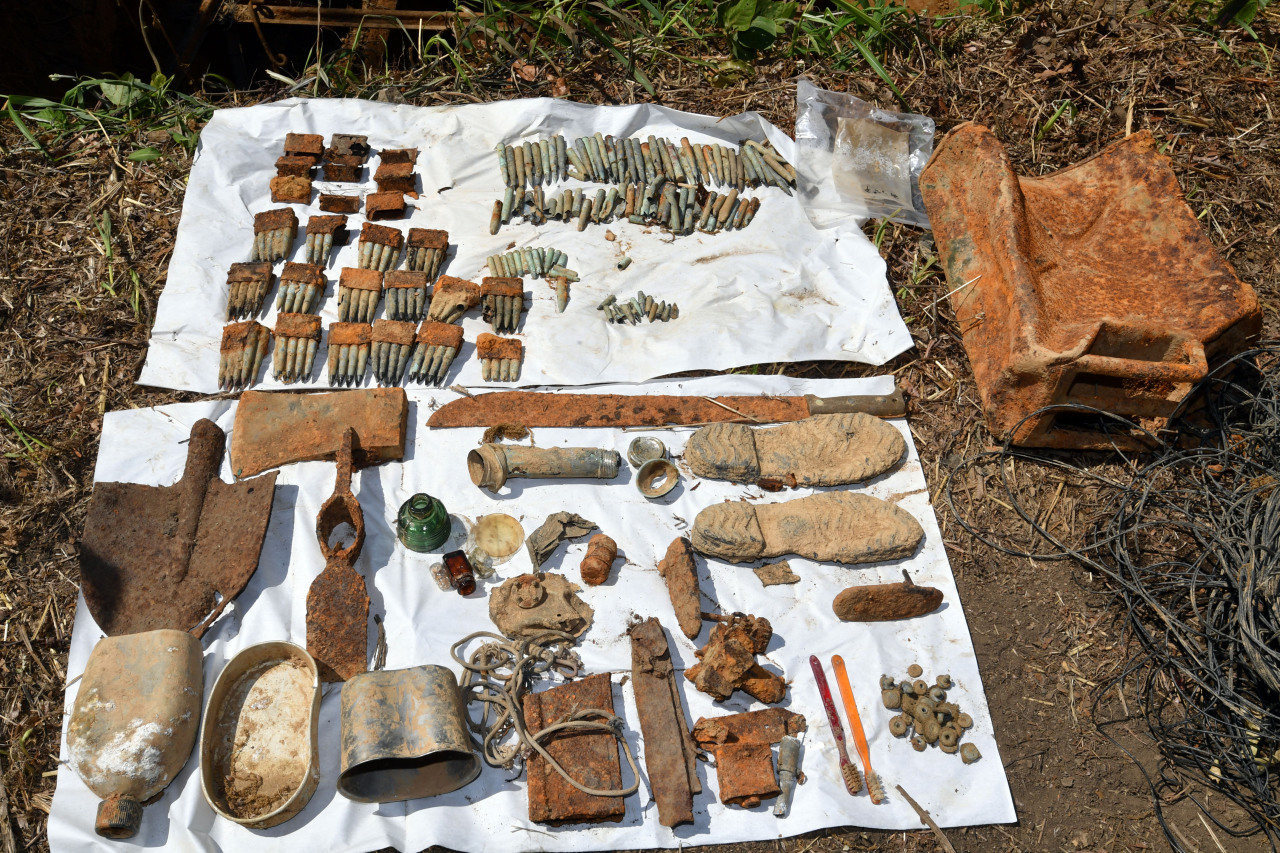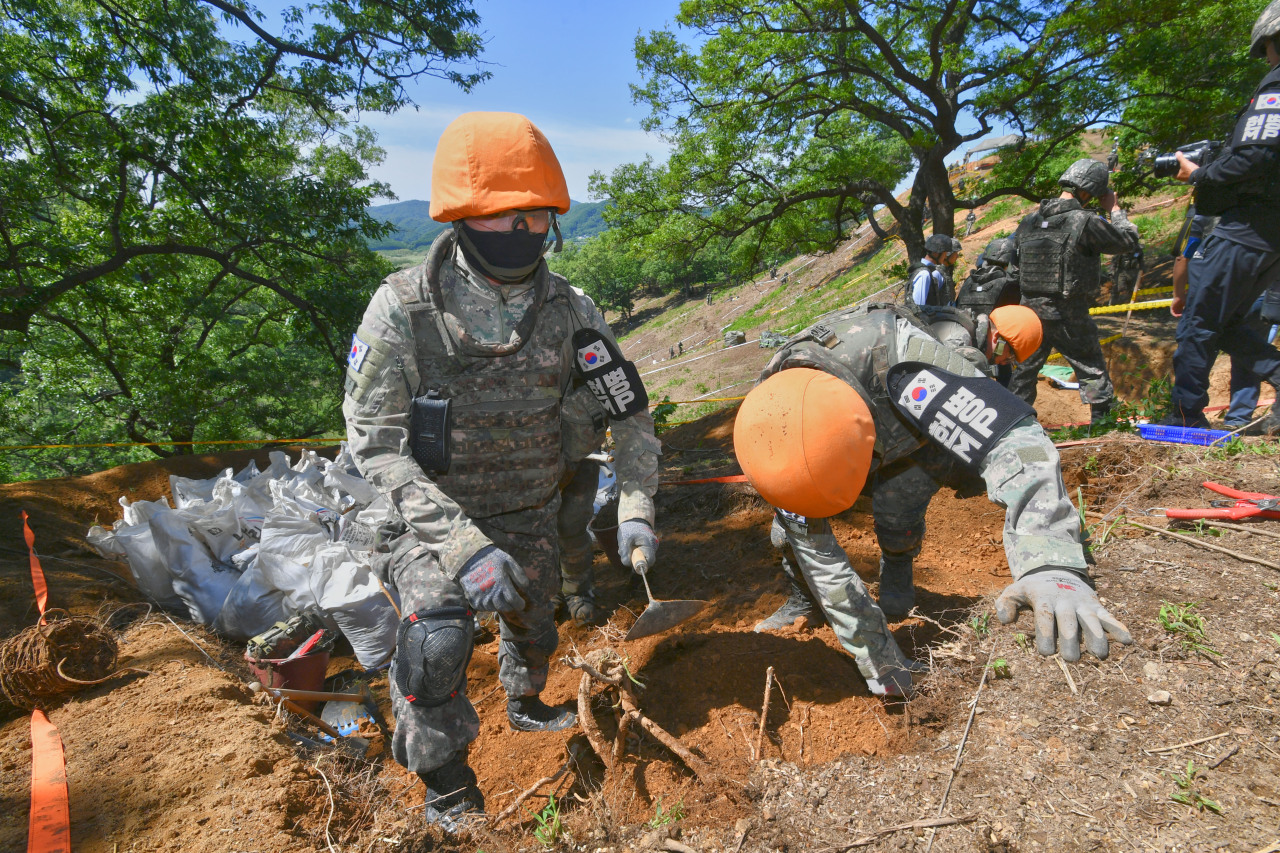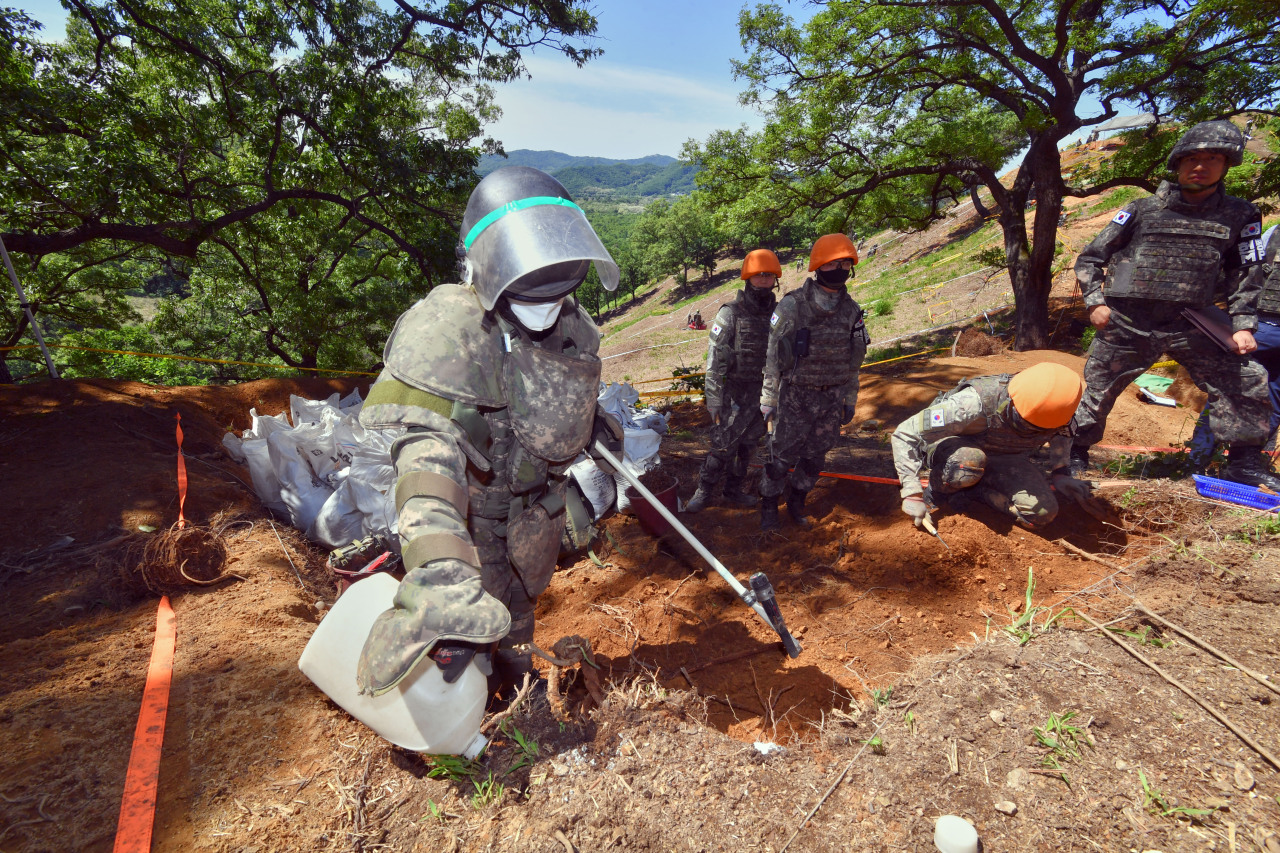CHEORWON, Gangwon Province -- A helmet with six bullet holes, a canteen pierced 23 times and a rifle with a round of ammunition left in the chamber. On Tuesday, those traces of the Korean War were found just where the war had left them, on the untouched highland of Arrowhead Ridge inside the Demilitarized Zone.
The scene is where more than 300 young South Korean, French and American soldiers died fighting the North Korean and Chinese forces. The other side is believed to have lost some 3,000 soldiers during the battle for the ridge.
In an attempt to return the fallen troops to the arms of their families, the two Koreas agreed to conduct a joint recovery project on the ridge last year, but only South Korea began the work on the promised date, April 1.

Items that belonged to soldiers killed in combat during the 1950-53 Korean War are excavated at Arrowhead Ridge in the border town of Cheorwon, Gangwon Province, in the Demilitarized Zone on Tuesday. (Yonhap)
“The scene is just as it was when the war ended. Bodies and articles are being found at close intervals, and they are in (surprisingly good condition),” said Col. Moon Byeong-wook, the head of the Inter-Korean Joint Recovery Project task force at South Korea’s Ministry of National Defense Agency for KIA Recovery and Identification. KIA stands for “killed in action” and the agency goes by the abbreviation MAKRI.
According to Moon, Arrowhead Ridge has produced more remains that have retained more of their original form than other sites, where war remains are often fragmented or lost.
The battlefield was uncovered for the first time, as the DMZ has remained a “no-man’s land” since the armistice agreement was signed in 1953.
“According to the testimonies of war veterans, about 1,000 shells fell on the land,” Master Sgt. Kang Jae-min, the chief leading one of the excavation teams there, explained.
Since the recovery work began, MAKRI had found 325 body parts -- believed to be from about 50 soldiers -- and 23,055 articles of war as of May 27. The articles included an identification tag that belonged to a French soldier, five US bulletproof jackets and 14 gas masks used by Chinese soldiers, Moon explained.
When the reporters visited Tuesday, MAKRI had finished the recovery work on 12,650 square meters -- only about 1 percent of the area that the joint project is supposed to cover.
“If North Korea responds and joins the recovery project, the joint task here can be completed within this year,” Moon added. The Comprehensive Military Agreement, aimed to reduce hostilities between the two Koreas and including the joint excavation plan, was signed Sept. 19, but Pyongyang remains unresponsive to Seoul’s requests since the US-North Korea summit in February.
Several camp sites and small caves of diverse sizes were also discovered in the area, where the allied troops would have huddled to avoid volleys of bullets, according to MAKRI.

South Korean military personnel and officials from the war remains recovery agency MAKRI conduct excavation work at Arrowhead Ridge in the DMZ on Tuesday. (Yonhap)
Currently there are eight teams, each including excavation, investigation and identification experts dispatched across the country. For Arrowhead Ridge, six teams were deployed, along with some 100 soldiers from nearby units for demining and excavation work.
Last year, the two Koreas worked together to demine the project area. As of Sunday, 149 land mines and 2,403 unexploded bombs had been removed from the region, according to MAKRI.
Repatriation of the fallen South Korea started the nationwide recovery project across the country in 2000, as part of the government’s plan to commemorate the 50th anniversary of the Korean War that year. This year marks the 69th anniversary.
While the project first began as a temporary task led by the South Korean Army, the Defense Ministry took over and established MAKRI in 2007 to bring back about 124,000 fallen heroes of the Korean War thought to be buried across the country.
“The project kicked off to bring back the soldiers, who would still be lying crouched under the cold ground, and return them to their families. It is the duty of the nation,” Ahn Sun-chan, the head of the MAKRI investigation team in charge of the DMZ area, told The Korea Herald.
“It is also important that people know life was sacrificed for the peace we enjoy now.”
MAKRI is said to be one of the only two entities in the world that systematically conduct recovery projects, the other one being the US Defense POW/MIA Accounting Agency or DPAA. The abbreviations in its name stand for “prisoners of war” and “missing in action.”
When MAKRI finds the remains of a foreign soldier, it informs the concerned government and either repatriates the body or buries it in the United Nations Memorial Cemetery here in Busan. For American soldiers, MAKRI conducts joint analyses with the US DPAA.

South Korean military personnel and officials from the war remains recovery agency MAKRI conduct excavation work at Arrowhead Ridge in the DMZ on Tuesday. (Yonhap)
“Other countries like Japan and Vietnam have also expressed interest in creating their own recovery teams,” Ahn said.
As of Sunday, 11,550 body parts, of which 10,221 are thought to be from allied soldiers, have been found. But only 132 soldiers had been returned to their families.
MAKRI is responsible not only for excavating the remains, but also for carrying out preliminary inspections to determine age, gender, height and race. Military documents recorded at the time, testimony from war veterans and articles found around the remains are all used in the identification work.
“Fabrics all rot away and we analyze what’s left -- the buttons, buckles and soles of shoes,” Ahn said, adding that identification tags and names inscribed on things like water bottles are precious finds.
The final step before a body can be returned to the bereaved family is DNA analysis, which is conducted separately at the Defense Ministry’s Criminal Investigation Command.
While MAKRI is in charge of collecting and managing DNA samples from the bereaved families to send to the analysts, gathering the data is a slow process. To date, the agency has collected some 43,000 samples, not nearly enough to make adequate progress.
To speed up the process, since April MAKRI has provided rewards to family members who provide their DNA.
By Jo He-rim (
herim@heraldcorp.com)








![[KH Explains] How should Korea adjust its trade defenses against Chinese EVs?](http://res.heraldm.com/phpwas/restmb_idxmake.php?idx=645&simg=/content/image/2024/04/15/20240415050562_0.jpg&u=20240415144419)